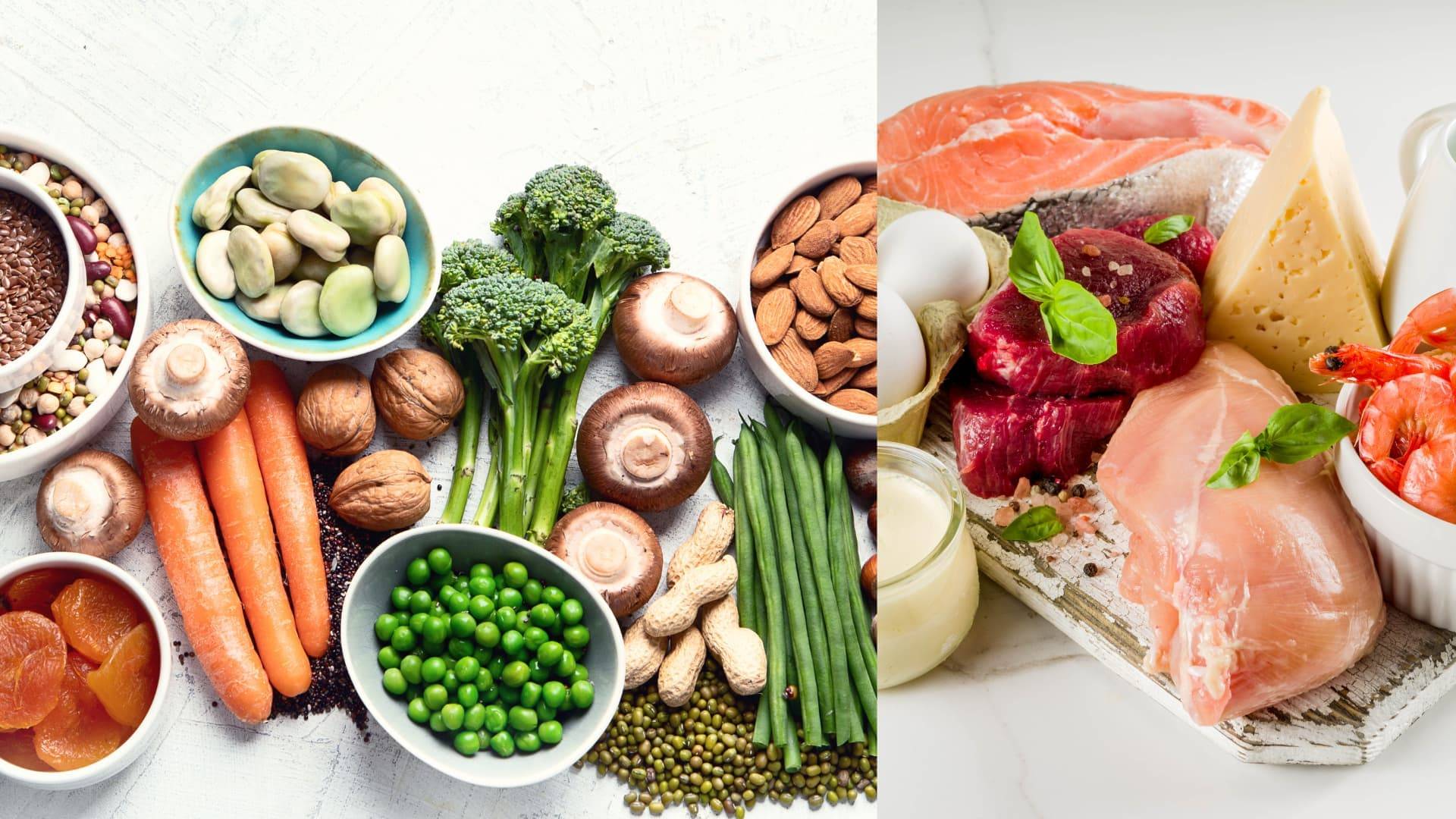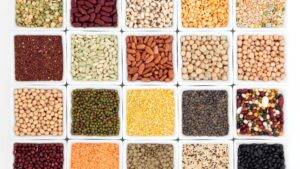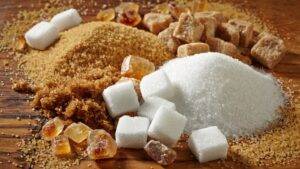“Plant-based diets are superior to animal-based diets because animal-based diets destroy the environment”. Another says “animal-based diets are definitely needed for the complete nutrients”
It’s ok to argue. But what if the answer is more about finding a balance rather than choosing extremes?
Over a few years now, I’ve come to a deep realization that nature thrives on balance. In this article, you’ll discover how balanced eating is a more grounded approach to sustaining your health through your food choices.
The Extremes: Plant-Based vs. Animal-Based Diets
Plant-based diets
Let’s start from a plant-based diet, what is it? It’s a diet that focuses mainly on food derived from plants. Which means, in some cases, someone could still eat animal foods but most of their food is from plants.
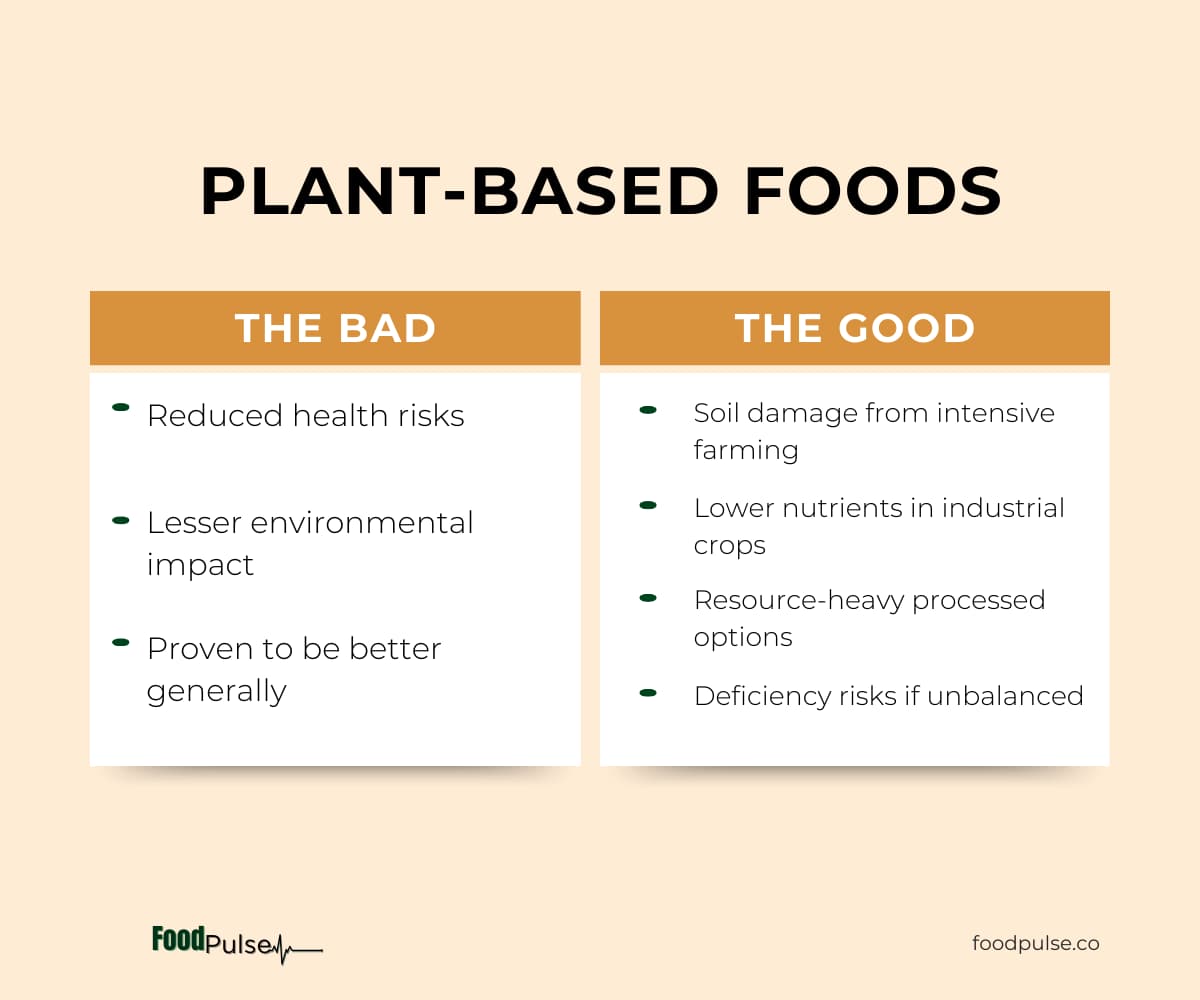
You may agree that plant-based diets have a less negative effect on the environment. For instance, this research led by Sabate says producing 1kg of protein from kidney beans requires approximately 10 times less water than 1kg of protein from beef.
Plant-based diets also have many health benefits like lower risks of heart disease, hypertension, and certain cancers. Note that the emphasis here is on fruits, vegetables, whole grains, and legumes, rather than (ultra)processed plant-based diets.
Fair enough. But intensive farming of plants, such as prolonged monoculture has damaged soil biodiversity and causes leaching of heavy pesticides into water bodies. No one talks about the amount of resources (including water) used to produced (ultra)processed plant-based foods. Neither do people talk about the reduced nutrients in fresh produce from big industrial agriculture. Plus imbalanced consumption of plant-based food leads to nutrient deficiencies, and in some server speculated cases, death.
Animal-based diets
Animal-based diets do have some plant components but they’are heavy on the animal side. These diets provide essential nutrients that you can’t easily get from plant foods – vitamin B12, omega-3 fatty acids, and heme iron.
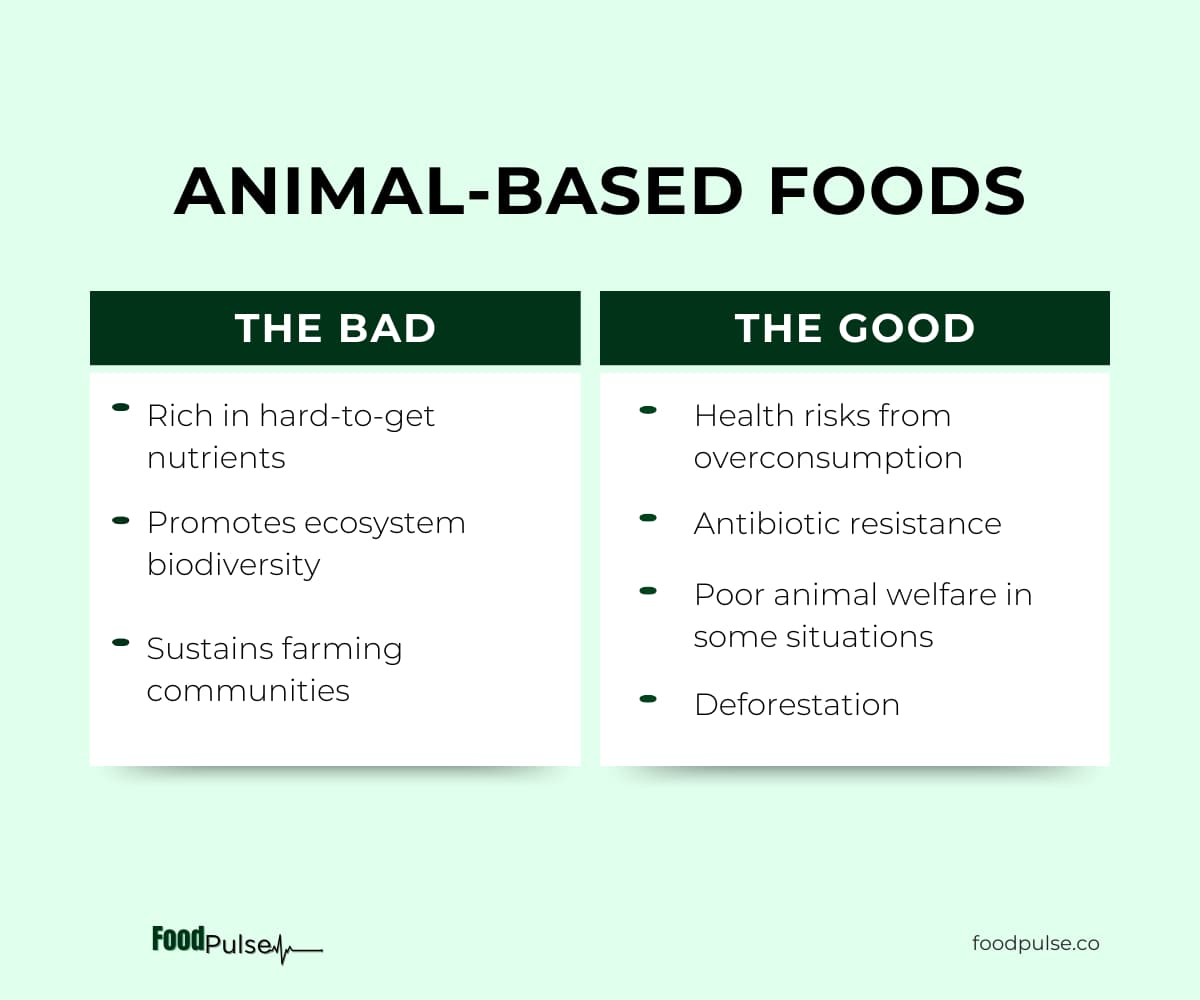
Moreover, livestock are essential in many agricultural systems. They contribute to soil health, biodiversity and ecological balance through activities like rotational grazing, manure production and nutrient cycling.
Animal products are also a core part of many traditional diets and cuisines worldwide. And some communities thrive on animal husbandry for livelihood. This makes a shift to plant-based diets somewhat impractical and potentially disruptive.
On the flip side, intensive industrial animal farming does not favor animal health, antibiotic resistance from industrial livestock practices is increasing, deforestation for grazing land and feed production, as well as water pollution from concentrated animal feeding operations, and excessive consumption of animal-based foods causes health issues. These and other make animal-based foods unfavourable.
How about balanced eating?
The principle of balance is a timeless concept found in various philosophical traditions. Aristotle’s doctrine of the mean advocates for moderation and balance between extremes. In Eastern philosophy, Taoism emphasizes harmony and balance with nature. Similarly, ecology dwells on interconnection and balance within ecosystems. And this report by Prof. Mark Lawrence explains balance, moderation and variety as the basis of a healthy and sustainable diet.
Look at this case
A farmer tends to corn fields alongside goats and chickens. He uses manure from animals, and mulch to enrich the soil and nourish young corn plants. When he harvests the corn, he uses some to feed the animals.
The farmer intercrops groundnuts, beans and peppers between the corn. He also uses pesticides, fertilizer and antibiotics – enough to maintain plant health rather than force growth.
This system creates a stable natural cycle. And research does confirm its benefits – better biodiversity, cleaner food and long-term sustenance.
While this perfect system may seem out of reach, that’s how it was a few years back and still so in some places. People got food from the corn fields and animals, that’s, something from the plants and something from the animals, while they maintain the cycle.
There are bigger systemic challenges with this perfect system. For example, such a system may not support the growing population. (“May” because most people are not producing even a drop of their own food). But it looks like the current system though feeding the growing population, has led to poorer quality of life, with diseases like diabetes and obesity being the order of the day.
Maybe we should be talking about a middle ground rather than leaning towards extremes. For instance, how we can scale this traditional system and operate it at its optimum efficiency without using forceful methods. Maybe that would be a better approach.
And in case you’ve been wondering about plant-based foods and plant-based meats, here’s a quick LinkedIn insight for you.
Balanced eating, where should we draw the line?
This balance means finding a middle ground that dwells on the benefits of plant and animal foods and reduces their negative impacts. This balance is not fixed in stone; it’s dynamic. It varies based on individual needs, cultural contexts, geographical location, environmental conditions, financial situation, and many many more factors.
The Canada’s food guide says half your plate should be fruits & veggies, a quarter should be whole grains and another quarter should be proteins. Which means ¾ is from plants and ¼ could be from animals. So let’s assume this is the balance point 75% plant food and 25% animal food.
This 75-25 proportion is not fixed in stone but some people’s (or most people) diet patterns at around 50-50 or even 25-75. To achieve balance, the goal should be to try and revert to 75-25; not to eliminate animal products and blame it for all the climate change and environmental havoc.
Indeed, animal farming has received so much backlash and negative reputation in media, scientific domains, and other places. With little mention of the havoc plant foods (especially industrial agriculture) also cause.
As a human, you need to eat. You can’t say both animal and plant farming destroys the environment, and therefore, you won’t eat again. Instead, we should be looking at how we can leverage the good sides of both plant and animals foods, and reduce their downsides.
Health benefits of balanced eating
By now, you know a balanced diet has many health benefits. For the sake of emphasis, let’s mention them one more time. A balanced diet:
- provides a diverse range of nutrients
- can help prevent nutrient deficiencies
- supports overall health and wellbeing
The Mediterranean diet, which literally everyone aspires to eat daily emphasizes fruits, vegetables, whole grains, nuts, and moderate amounts of fish and poultry. And many studies such as this one led by Dr Valeria Tosti have already proven its many health benefits, including reduced risks of heart disease and improved cognitive function.
You may not have access to a Mediterranean diet, but you have access to a variety of plant and animal foods. And you can combine them in meaningful proportions to get similar health benefits.
Action steps for a balanced eating
Here are action steps you can take for a better balance of plant and animal foods in your diet.
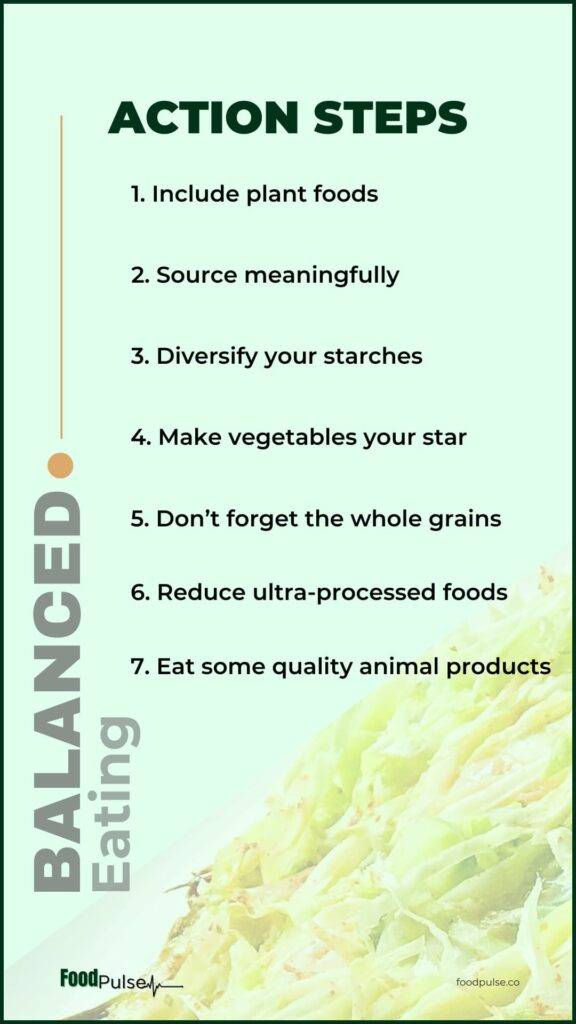
1. Eat more plant foods
- Fruits should always be on your grocery list
- For each grocery run, add 2-3 different fruit varieties
- Keep nuts within easy reach for healthy snacking
- Always stock (pre-cooked) pulses & legumes for quick addition to your meals
- Consider starting a small (bucket) garden
3. Diversify your starches
- Explore beyond potatoes, with nutritious alternatives like plantains, taro, and yams
- Incorporate these into balanced meals with stews, beans, or fresh sauces
4. Make vegetables your star
- Add colorful veggies to salads, soups and stews
- Vary them in cooked, blanched and raw forms
- Explore new veggies, one in each grocery run for variety
5. Don’t forget the whole grains
- Wheat, rice, sorghum, millet, corn, there’s a lot here
- Here’s a 3-ingredient nutrient-dense recipe suggestion for you: mina-di-sona
6. Reduce ultra-processed foods
- Work on gradual reduction rather than an abrupt cut
- Focus on practical long-term changes that fit your lifestyle
- If this is all you can access, then read the ingredient list to understand what you’re taking in
7. Include some quality animal products
- Use eggs, dairy, meats, and fish as modest parts of your meal
- Remember: plant foods are always the main attraction
- Definitely skip this if you’re a vegan or vegetarian
Choose balanced eating
If it’s about better personal health and ecosystem, then a complete shift to one side of the spectrum is not the answer. A shift to more animal food has already caused a lot of problems.
Balanced eating between plant and animal foods, with plant foods being the star and animal foods being the support, that is what you should be aiming for. And if you’re vegan, make sure to plan your protein and other critical nutrient needs.
The timeless concept of balance, and balanced eating for that matter, has always prevailed in many systems and this is no exception. In your choice of food, find that balance point that nourishes you and preserves resources for continuous sustenance of the system.
2. If you can, source meaningfully
- Choose local markets and small farmers when possible
- Consider starting a small (bucket) garden
3. Diversify your starches
- Explore beyond potatoes, with nutritious alternatives like plantains, taro, and yams
- Incorporate these into balanced meals with stews, beans, or fresh sauces
4. Make vegetables your star
- Add colorful veggies to salads, soups and stews
- Vary them in cooked, blanched and raw forms
- Explore new veggies, one in each grocery run for variety
5. Don’t forget the whole grains
- Wheat, rice, sorghum, millet, corn, there’s a lot here
- Here’s a 3-ingredient nutrient-dense recipe suggestion for you: mina-di-sona
6. Reduce ultra-processed foods
- Work on gradual reduction rather than an abrupt cut
- Focus on practical long-term changes that fit your lifestyle
- If this is all you can access, then read the ingredient list to understand what you’re taking in
7. Include some quality animal products
- Use eggs, dairy, meats, and fish as modest parts of your meal
- Remember: plant foods are always the main attraction
- Definitely skip this if you’re a vegan or vegetarian

